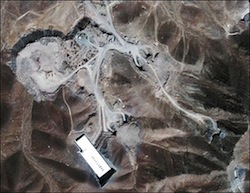Iran's Clandestine Nuclear Facilities: What We Know and What We Don't
September 29, 2009
Featured Image
Why Iran's Qom Plant Could Be Just the Tip of the Iceberg - James Acton and Nima Gerami in Foreign Policy [link]
- Unfortunately, the Qom facility might not be the end of the story. A centrifuge plant needs feedstock, uranium hexafluoride -- a material derived from refined uranium ore and produced at a conversion plant. [...] Iran could therefore have also set up a clandestine conversion facility, or have succeeded in procuring the material illicitly.
- The revelation of the Qom facility -- hidden from the international community and not declared to the IAEA as required -- demonstrates that, contrary to its protestations, Iran is not complying with its international obligations and that its nuclear program does have a military dimension.
Qom Enrichment Facility Roundup - Arms Control Wonk [link]
- There has been a lot of back-and-forth on the blog, especially in the comments, about the ongoing revelation of Iran’s enrichment facility near Qom. A couple of points:
- Iran has unequivocally violated its safeguards obligations
- The location of the facility itself is the matter of some debate
Iran's Hidden Nuclear Facility - Interactive Feature in the New York Times [link]
- Images show the details of a hidden facility in Iran that experts say is the nuclear site recently disclosed by the Obama administration.
- Click here to view a slideshow of images of the Qom nuclear site.
The New Iran Sanctions: Worse Than the Old Ones - Gal Luft in Foreign Policy [link]
- In an effort to prevent Iran from becoming a nuclear power, the U.S. Congress has set its sights on the Islamic Republic's foreign gasoline dependence... There is just one problem: Iran is much less vulnerable to gasoline sanctions than is commonly believed on Capitol Hill, and its foreign gasoline dependence is dropping by the day.
- The focus on such sanctions would be warranted if Iran's petroleum-products dependence were deep. But it is no longer the case. The wheels of Washington's bureaucracy have turned too slowly to keep pace with Iran's wiliness.
Arms Control Has Been Bipartisan - Thomas Graham in the Wall Street Journal [link]
- In response to Stephen Rademaker's recent WSJ op-ed, "Why Democrats Fail at Arms Control," Graham argues, "at least until 2001, the conduct of the strategic arms control process in the U.S. was remarkably bipartisan."
- As for the current negotiations, Mr. Rademaker claims that President Barack Obama overreached in trying to achieve deeper reductions in U.S. and Russian arsenals rather than simply "replacing the START verification regime."
- However, neither side favored a simple extension. Simply extending the Strategic Arms Reduction Treaty without deeper reductions in U.S. and Russian nuclear arsenals, fails to address the fact that the outdated START limits of 6,000 deployed strategic nuclear weapons are simply too high to be acceptable in today's world.
- Legally binding and verifiable arms reductions remain vital tools to strengthen U.S. security.
- Nod to Nukes of Hazard.



